Research - (2020) Advances in Dental Surgery
Epidemiology of Occupational Diseases in the Russian Federation Characteristics Causes and Risks
Arthur Amirovich Almukhametov1*, Ilia Vladimirovich Petrov2, Firuza Salavatovna Petrova2, Rybakova Svetlana Viktorovna1 and Tanzilya Khafizovna Amirova2
*Correspondence: Arthur Amirovich Almukhametov, Federal University, "Kazan State Medical University" Russian Ministry of Health, Russia, Email:
Abstract
The epidemiology of occupational diseases examines the distribution of events and determinants related to health, as well as their relationship with the work environment, risks and prevention. The authors determined that this study is aimed at epidemiological characteristics of occupational pathologies in the Russian Federation for 2014-2018, considering risks and causes. We analyzed the official data of the state reports of the Federal Service for Supervision of Consumer Rights and Human Well-Being Protection “On the State of Sanitary and Epidemiological Well-Being of the Population of the Russian Federation” from 2014 to 2018. It was found that the incidence of occupational diseases decreased by 32.7%. Occupational diseases are most often recorded among men (2014 - 85.3%; 2018 - 87.76%). During periodic medical examinations of workers, professional pathologies are recorded more often than with active address. By the course nature, the largest share in the structure of occupational diseases is accounted for by chronic pathologies (>90%). Sensorineural hearing loss is the leading nosological form due to the influence of physical factors of production processes (>50%). Mining is a leading industry for the registration of occupational diseases among workers. Noise prevails in the structure of analysis of industrial enterprises' workplaces that do not meet sanitary and epidemiological requirements for physical factors. Imperfections in technological processes (>49%), structural deficiencies in labor means (>34%), imperfections in jobs (>3.4%) and sanitary requirements (>2%) are the leading causes of the development of chronic occupational pathologies. Pathologies associated with exposure to physical factors (>46%) prevail in the structure of occupational diseases for 2014-2018.
Keywords
Occupational pathologies (diseases), Development risks, Risk factors, Epidemiology of occupational diseases
Introduction
As long as there is work in the socio-economic sense [1,2], there will be occupational diseases and the need for epidemiological studies designed to characterize the health risks of workers and the development of preventive measures will be relevant [3-6].
The epidemiology of occupational diseases examines the distribution of events and determinants related to health, as well as their relationship with the work environment (workplace). Environmental epidemiology focuses on the involuntary effects of physical and chemical factors indoors or outdoors, which may affect health. The epidemiology of occupational pathologies and the epidemiology of environment use a similar methodology, although the conditions vary. Thus, the epidemiological studies of environment go beyond the impact of specific environmental and hygienic factors on health and should take into account the long-term impact of ecological systems on neighboring populations. Molecular technologies make it possible to detect effects at the molecular level that occur at very low levels of exposure to the environmental factors, which is actively used in the epidemiological studies and allows developing preventive measures at this stage [7,8].
It was established that the variability of exposure to harmful factors in the work environment is important in planning and conducting epidemiological studies of occupational diseases. Thus, to assess the impact of this variability in the production of rubber and rubber products, the scientists from the University of Utrecht (Utrecht, the Netherlands) conducted a study of the effectiveness of various exposure schemes for solids (soluble in cyclohexane), pollutants and solvents. This study emphasized the established significance of exposure variability [9].
Chemical and biological factors at the workplaces are one of the fundamental factors in establishing compensation payments for various professions and positions. Thus, the biological factor and preventive measures used to eliminate it are ubiquitous for medical personnel. This factor contributes to the specific nature of organizing the work process [10].
This study is aimed at giving the epidemiological characteristics of occupational pathologies in the Russian Federation for 2014-2018, identifying risks and causes.
Methods
The authors of this article analyzed the official data of the state reports of the Federal Service for Supervision of Consumer Rights and Human Well-Being Protection (Rospotrebnadzor) “On the State of Sanitary and Epidemiological Well-Being of the Population of the Russian Federation” from 2014 to 2018. When processing the results obtained in the course of this study, we used epidemiological methods and generally accepted variation statistics taking into account the reliability degree of results and the compliance of epidemiological studies with the evidence-based medicine criteria.
Results
The risk of acquiring occupational pathology is characterized by multifactorial nature. Thus, both production (labor protection level, working conditions, professional rehabilitation, level of protective equipment application) and socioeconomic factors (standard of living, social and family adaptation, personal potential of the employee’s health) have a significant impact. The working conditions can be defined as the main risk factor for the formation of professional and professionally determined pathology. The professional health of workers and the conservation of labor resources is ensured by assessing the level of harmful effects of individual labor factors and developing mechanisms for their management in order to reduce acceptable risk levels.
An analysis of the incidence of occupational pathologies demonstrates a significant downward trend in the Russian Federation (y = -0.148x + 1.912, R2 = 0.9917; Figure 1). For 2014-2018, the incidence of occupational diseases decreased by 32.7% (2014 - 1.74; 2018 - 1.17 per 10 thousand people, respectively).
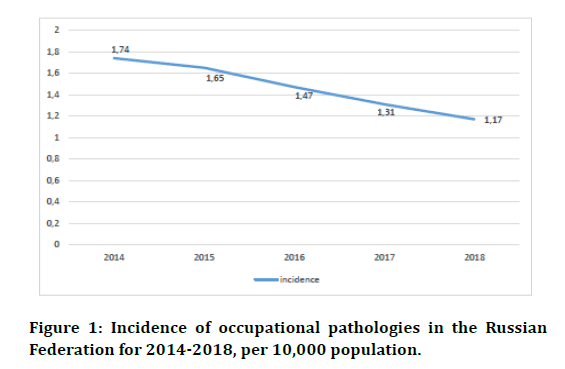
Figure 1: Incidence of occupational pathologies in the Russian Federation for 2014-2018, per 10,000 population.
An analysis of the gender structure revealed that occupational diseases prevail in men. Over the analyzed period, the ratio between men and women has not changed. Thus, there were 85.3% men and 14.7% women in 2014. In 2018, the gender structure was as follows: 87.76%-men, 12.24% - women (Figure 2).
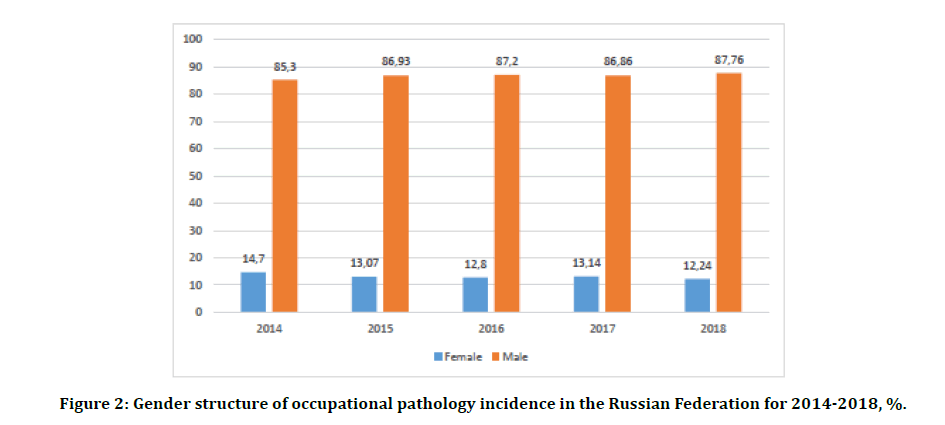
Figure 2: Gender structure of occupational pathology incidence in the Russian Federation for 2014-2018, %.
Periodic medical examinations remain an effective tool for identifying occupational diseases (2014-65.05%; 2018-58.13%). The share of occupational pathology cases with active address of employees during the analyzed period increased from 34.95% in 2014 to 41.87% in 2018 (Figure 3).
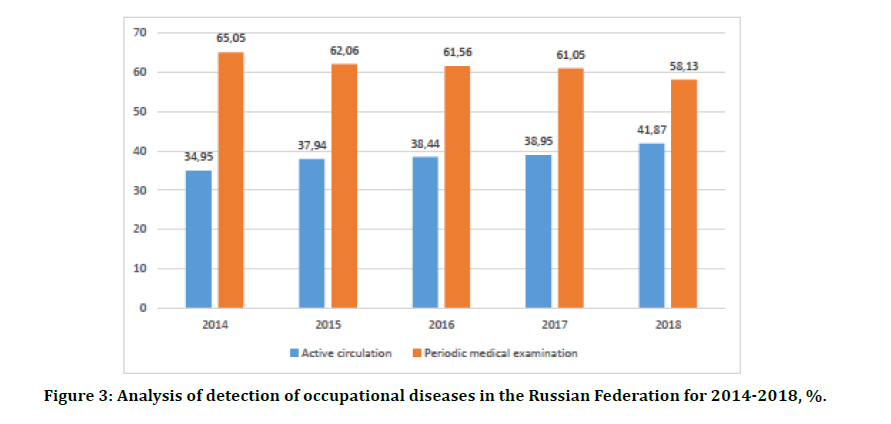
Figure 3: Analysis of detection of occupational diseases in the Russian Federation for 2014-2018, %.
According to the course nature of occupational diseases, it is worth noting that the largest share in the structure is accounted for by chronic pathologies (>90%). For 2014-2018, the structure of diseases has not changed in this parameter. In 2014 and 2018, the chronic course of occupational pathologies accounted for 99.4%, and of acute occupational diseases-0.6% (Figure 4).
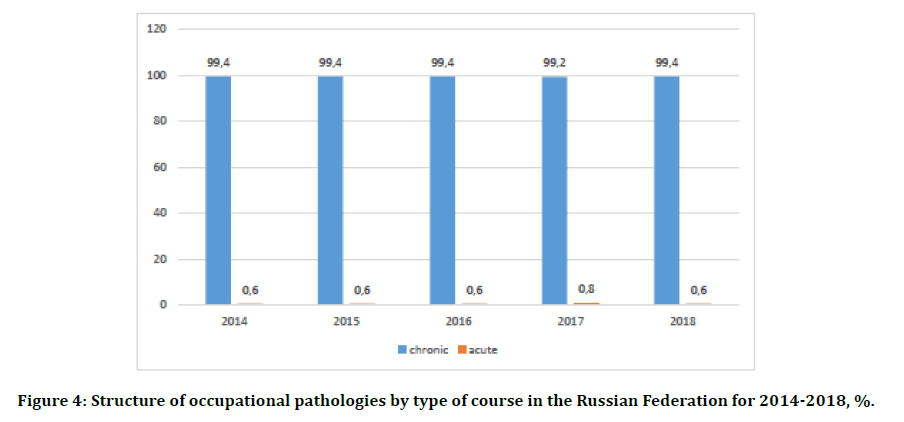
Figure 4: Structure of occupational pathologies by type of course in the Russian Federation for 2014-2018, %.
Sensorineural hearing loss is the leading nosological form of occupational pathologies because of physical factors of production processes for 2014-2018 (2014 - 59.05%; 2018 - 55.13%). There is an increase in vibrational disease in this structure (2014--37.51%, 2018- 42.88%). The share of mono- and polyneuropathy decreased from 3.2% in 2014 to 1.75% in 2018 over the studied period (Figure 5).
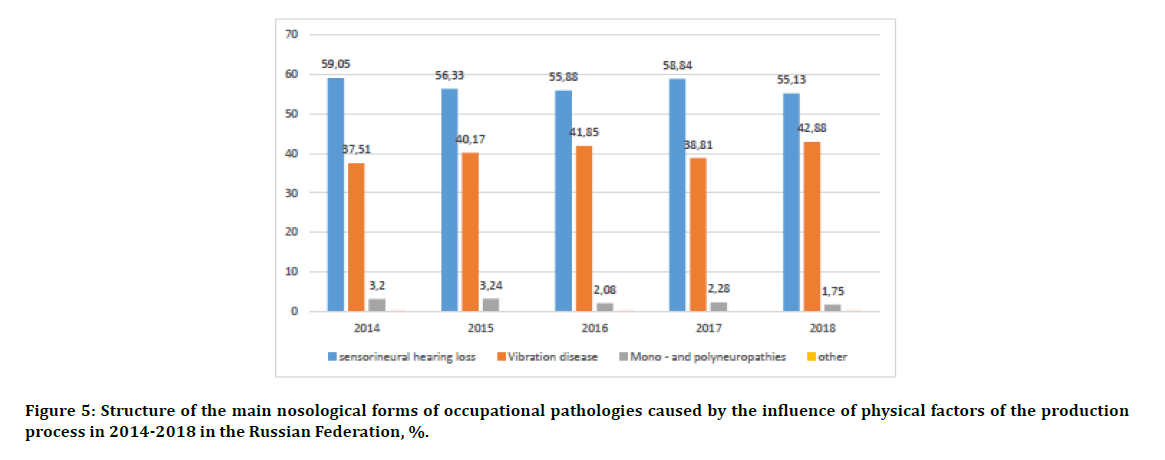
Figure 5: Structure of the main nosological forms of occupational pathologies caused by the influence of physical factors of the production process in 2014-2018 in the Russian Federation, %.
Mining is the leading industry in the registration of occupational diseases among workers for 2014-2018 (2014 - 38.46%; 2018 - 47.59%). The share of professional pathologies attributable to workers employed in manufacturing was 32.45% in 2014 and 27.32% in 2018. There is a decrease in the share of workers belonging to the "Agriculture, hunting and forestry"/"Agriculture, forestry, hunting, fishing and fish farming" for the analyzed period in the structure of occupational diseases by main types of economic activity from 5.54% in 2014 year to 3.97% in 2018. The share of occupational diseases in the "Transport and communications"/"Transportation and storage" decreased from 12.49% in 2014 to 10.56% in 2018 (Figure 6). The results obtained indicate the need for special attention to the preventive direction among workers engaged in mining. Making the right management decisions will reduce the occupational pathology incidence in this cohort.
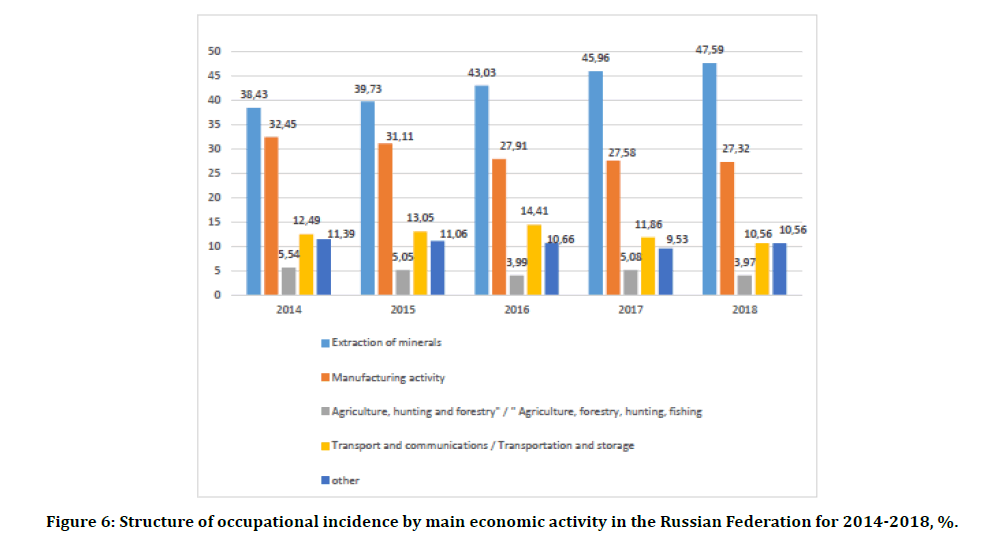
Figure 6: Structure of occupational incidence by main economic activity in the Russian Federation for 2014-2018, %.
An analysis of the industrial enterprises' workplaces that do not meet the sanitary and epidemiological requirements for physical factors made it possible to determine that noise predominates in this structure (2014 - 21.82%; 2018 - 17.41%). The share of workplaces with illumination as a factor that does not meet the requirements of sanitary legislation decreased from 16.04% in 2014 to 13.03% in 2018.
Vibration is also a significant factor in the workplace non-conformity, despite a decrease in this indicator. Thus, the share of such workplaces decreased from 12.52% in 2014 to 10.02% in 2018. The share of jobs with microclimate parameters that do not meet the sanitary and epidemiological rules shows a decrease from 5.85% in 2014 to 4.95% in 2018. The share of jobs with electromagnetic fields that do not meet the sanitary and epidemiological requirements increased from 4.55% in 2014 to 6.83% in 2018 (Figure 7).
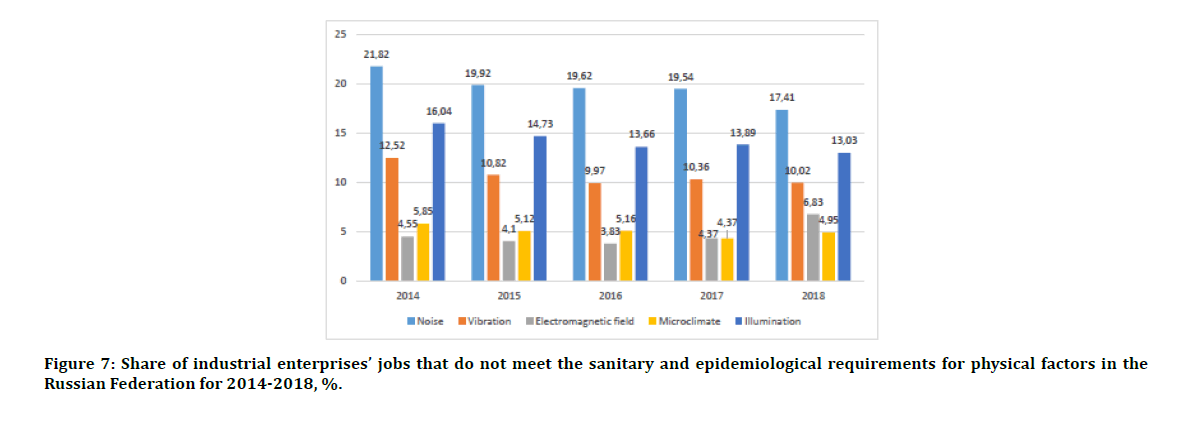
Figure 7: Share of industrial enterprises’ jobs that do not meet the sanitary and epidemiological requirements for physical factors in the Russian Federation for 2014-2018, %.
It was found during the analyzed period that chronic occupational pathology most often arose as a result of imperfection of technological processes (2014-49.6%; 2018-52.04%), structural deficiencies in labor tools (2014- 34.79%; 2018-38.22%), imperfections of the workplaces (2014-6.28%; 2018-3.43%) and sanitary facilities (2014-2.65%; 2018-2%) (Figure 8).
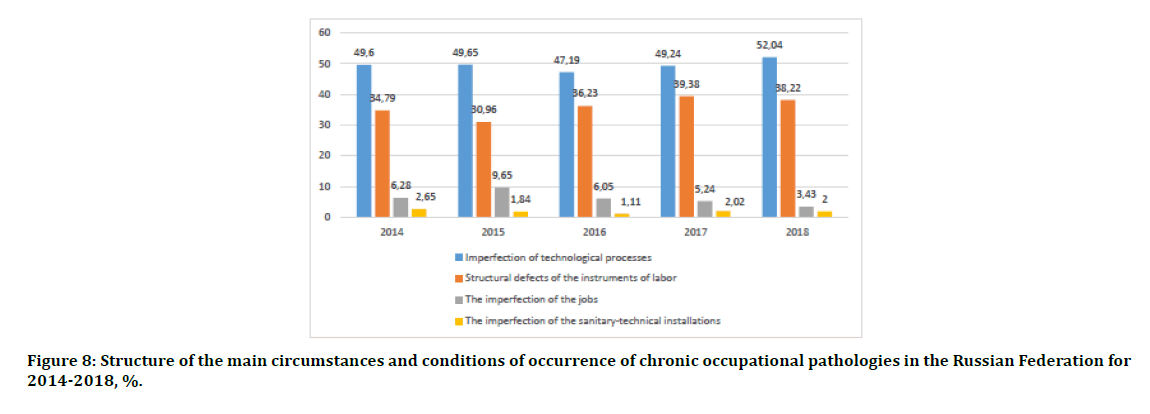
Figure 8: Structure of the main circumstances and conditions of occurrence of chronic occupational pathologies in the Russian Federation for 2014-2018, %.
It was found that the largest share in the structure of occupational diseases, depending on the etiology, is associated with the pathologies related to the effect of physical factors for 2014- 2018 (2014-46.79%; 2018-49.85%). The share of diseases associated with physical overload and overwork of individual organs and systems remained almost unchanged over the studied period (2014-25.18%; 2018-24.73%). The share of pathologies associated with exposure to industrial aerosols decreased from 17.56% in 2014 to 15.89% in 2018 (Figure 9).
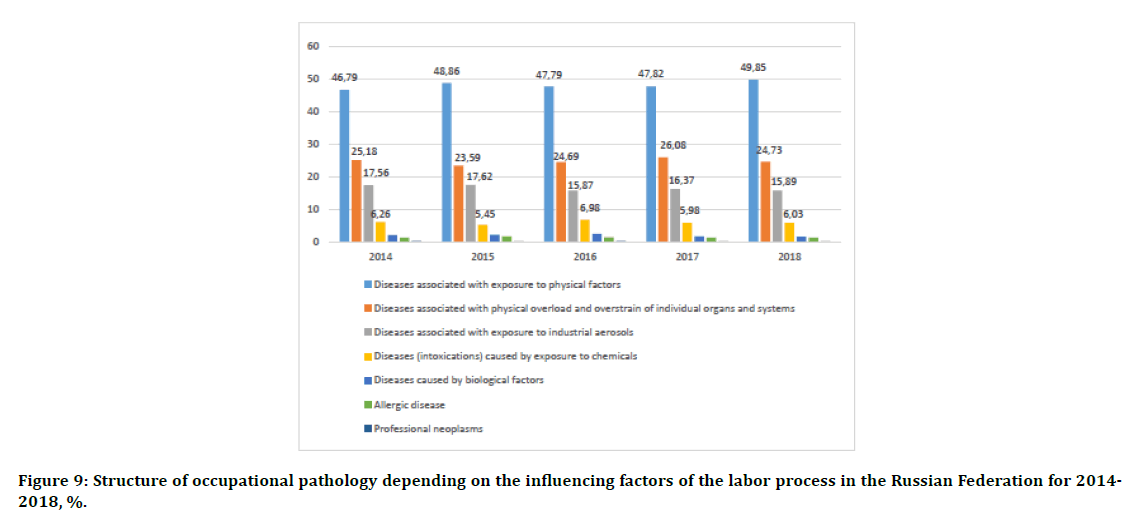
Figure 9: Structure of occupational pathology depending on the influencing factors of the labor process in the Russian Federation for 2014- 2018, %.
Summary
The study of the epidemiology of occupational diseases in the Russian Federation for 2014- 2018 led to the following conclusions:
The incidence of occupational diseases decreased by 32.7% in the Russian Federation.
An analysis of the gender structure revealed that occupational diseases prevail in men (2014 - 85.3%; 2018 - 87.76%).
The most effective tool for detecting occupational diseases is periodic medical examinations of employees, which account for > 58% of pathology registration cases (2014 - 65.05%; 2018 - 58.13%).
By the course nature, the largest share in the structure of occupational diseases is accounted for by chronic pathologies (> 90%).
Sensorineural hearing loss is the leading nosological form due to the influence of physical factors of production processes (> 50%).
Mining is the leading industry in the registration of occupational diseases among workers (2014 - 38.46%; 2018 - 47.59%).
Noise prevails in the analysis of industrial enterprises' workplaces that do not meet the sanitary and epidemiological requirements for physical factors (2014 - 21.82%; 2018 - 17.41%).
Imperfections in technological processes (> 49%), structural deficiencies in labor means (> 34%), imperfections in jobs (> 3.4%) and sanitary requirements (> 2%) are the leading causes of the development of chronic occupational pathologies.
Pathologies associated with exposure to physical factors (> 46%) prevail in the structure of occupational diseases, depending on the etiology.
Thus, the prevention of occupational pathologies is a complex problem requiring the improvement of various programs aimed at reducing the negative impact of production factors.
Acknowledgements
The work is performed according to the Russian Government Program of Competitive Growth of Kazan Federal University.
References
- http://www.bard.edu/library/arendt/pdfs/Marx-MarxEngels.pdf
- Shlender PE, Kokin Yu P, Yurist M. Labor economics. 2003; 20.
- Stayner LT, Collins JJ, Guo YL, et al. Challenges and opportunities for occupational epidemiology in the twenty-first century. Epidemiology in Occupational Health (EPICOH) conference, Chicago, 2017.
- Raj P, Hohenadel K, Demers PA, et al. Recent trends in published occupational cancer epidemiology research: Results from a comprehensive review of the literature. Am J Industrial Med 2014; 57:259-264.
- Moyce SC, Schenker MB. Occupational exposures and health outcomes among immigrants in the USA. Curr Envir Health Rpt 2017; 4:349–354.
- Rushton L. The global burden of occupational disease. Curr Envir Health Rpt 2017; 4:340-348.
- Velonakis EG. Environmental and occupational epidemiology principles. In book: Environmental exposures and human health challenges. 2019; 147-157.
- Loomis D, Kromhout H. Exposure variability: Concepts and applications in occupational epidemiology. Am J Industrial Med 2004; 45:113-122.
- Kromhout H, Heederik DJJ. Occupational epidemiology in the rubber industry: Implications of exposure variability. Am J Industrial Med 1995; 27:171-185.
- Boleij JSM, Buringh E, Heederik DJJ, et al. Occupational hygiene of chemical and biological agents. Elsevier Science Publishers, Amsterdam, 1995; 285.
Author Info
Arthur Amirovich Almukhametov1*, Ilia Vladimirovich Petrov2, Firuza Salavatovna Petrova2, Rybakova Svetlana Viktorovna1 and Tanzilya Khafizovna Amirova2
1Federal University, "Kazan State Medical University" Russian Ministry of Health, Russia2Mari State University, "Kazan State Medical University" Russian Ministry of Health, Russia
Citation: Arthur Amirovich Almukhametov, Ilia Vladimirovich Petrov, Firuza Salavatovna Petrova, Rybakova Svetlana Viktorovna, Tanzilya Khafizovna Amirova, Epidemiology of Occupational Diseases in the Russian Federation Characteristics Causes and Risks, J Res Med Dent Sci, 2020, 8 (7): 465-470.
Received: 27-Sep-2020 Accepted: 10-Nov-2020 Published: 17-Nov-2020
